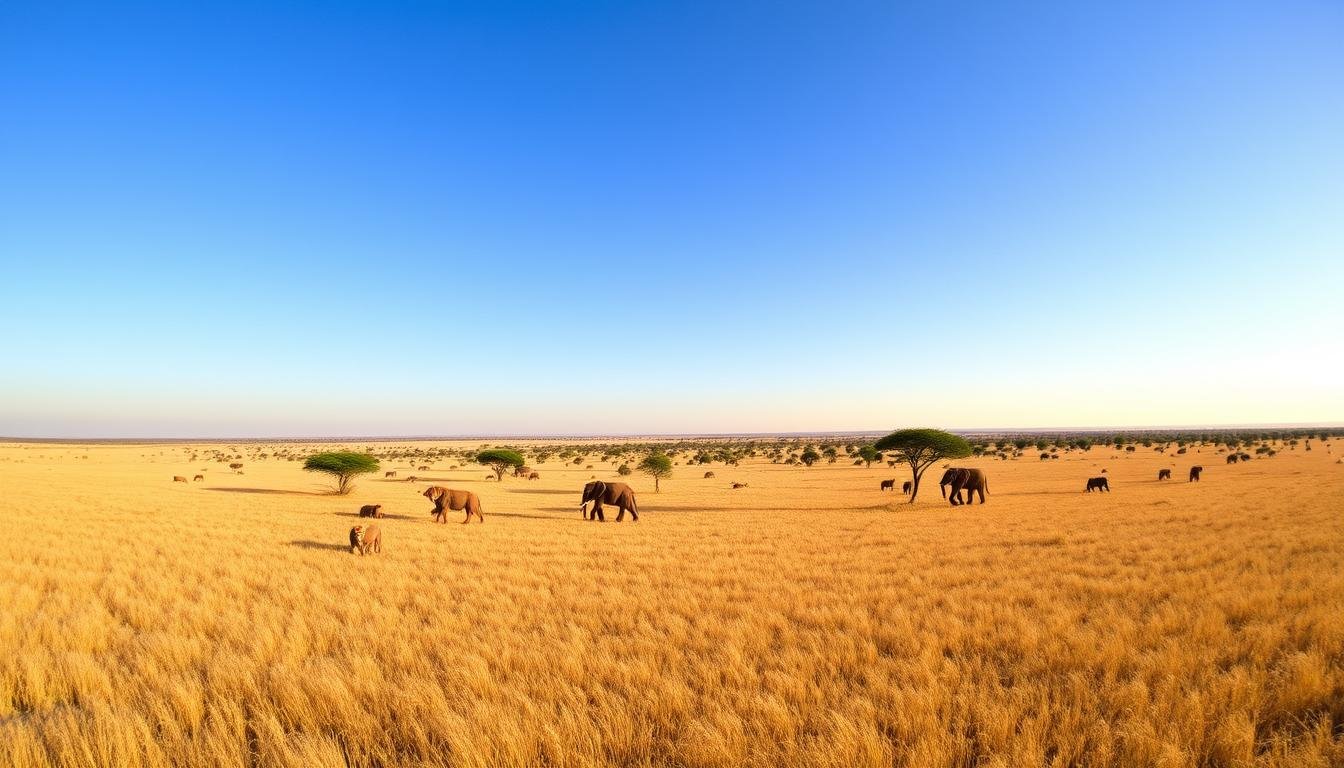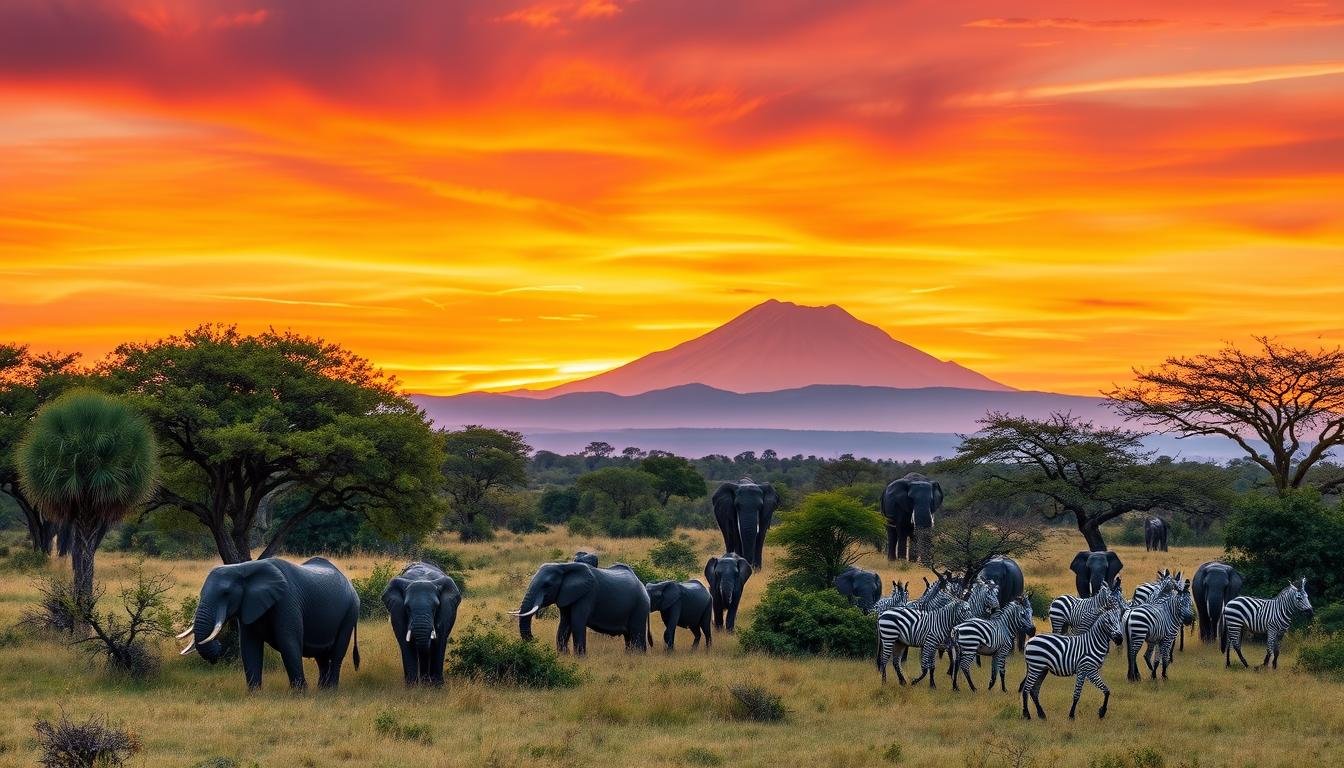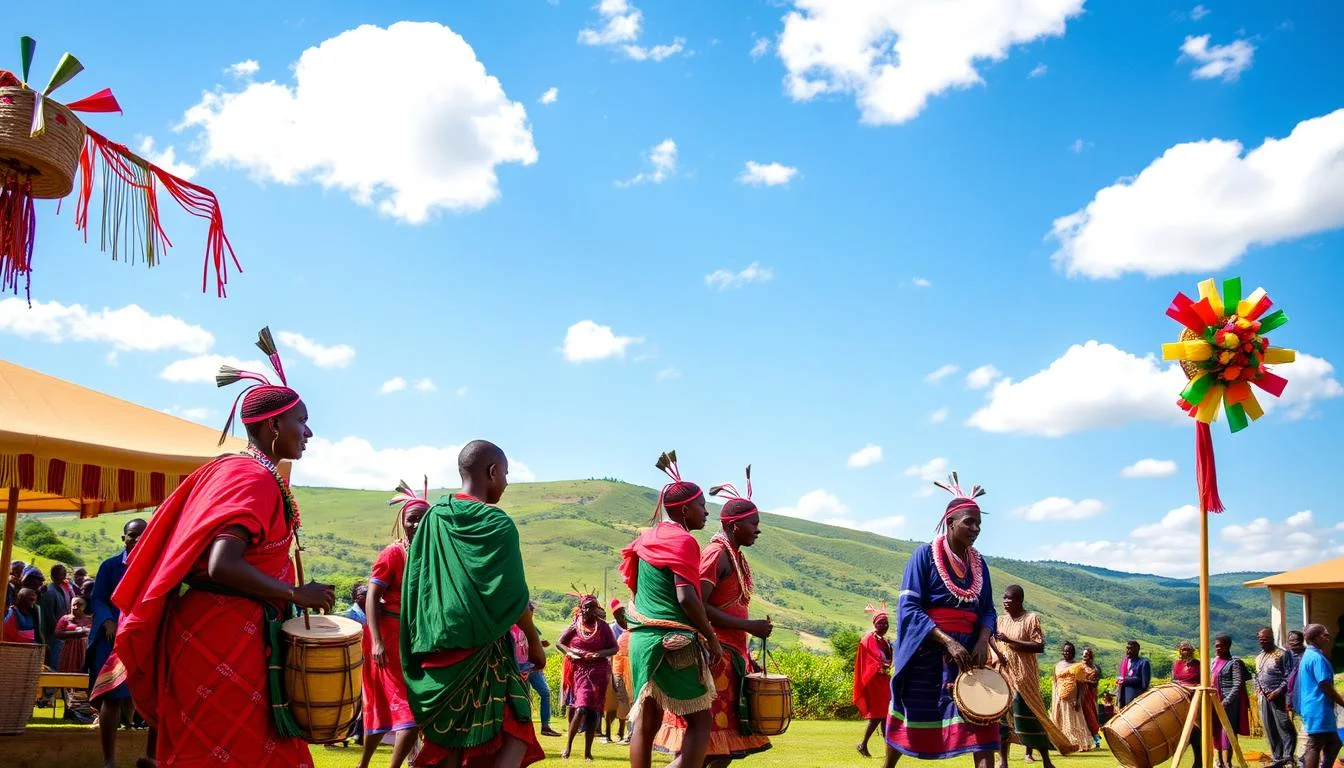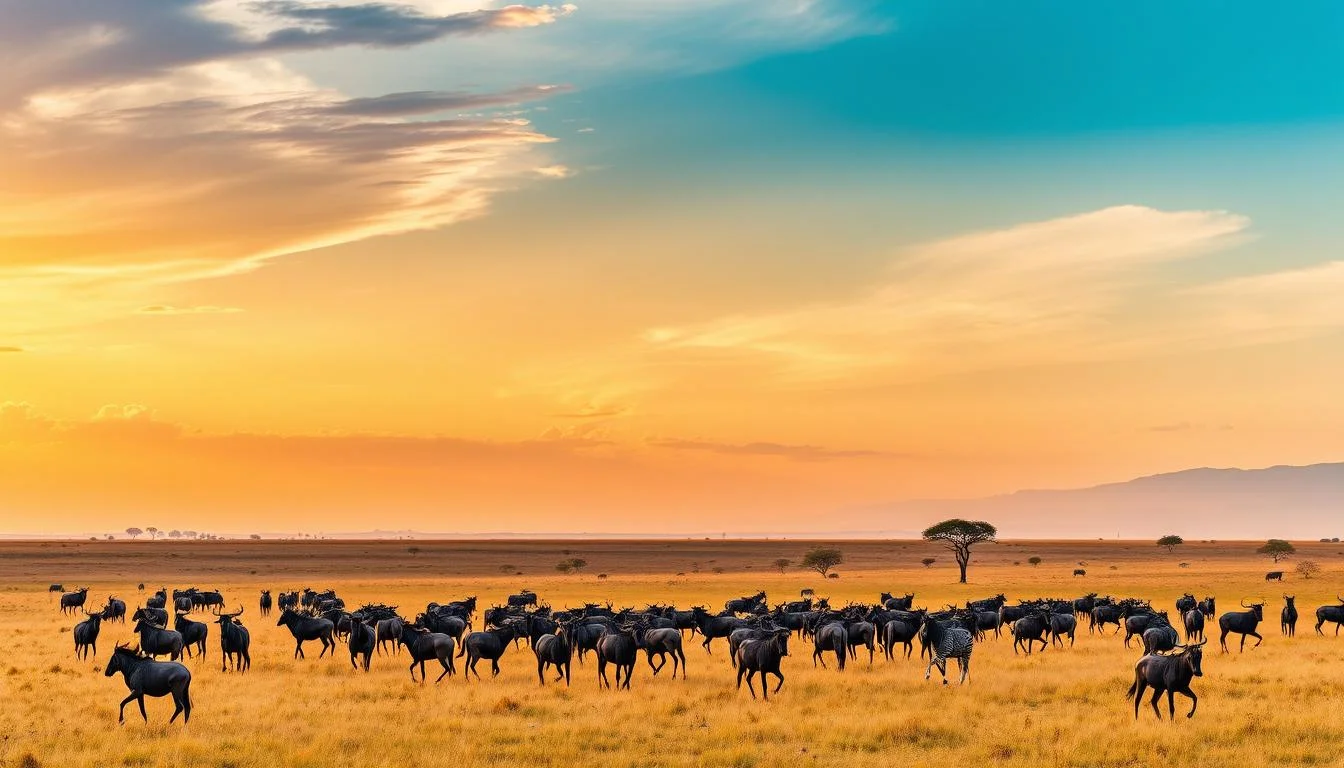Embarking on a captivating safari adventure in Tanzania requires careful consideration of the best times to visit. From the prime dry season for exceptional game viewing to the lush green season teeming with the iconic Wildebeest Migration, Tanzania offers diverse experiences throughout the year. This comprehensive guide will navigate you through the optimal periods to explore Tanzania’s national parks, witness the Wildebeest Migration, and enjoy the country’s diverse wildlife and natural wonders12.
Key Takeaways
- The prime dry season from June to October offers excellent game viewing as animals congregate around water sources.
- The Wildebeest Migration peaks in August and September, with the best river crossings in the northern Serengeti.
- The lush green season from November to May is ideal for witnessing the wildebeest calving and spotting migratory birds.
- Each of Tanzania’s national parks has its own seasonal highlights, making it essential to plan your safari accordingly.
- Factors like weather, crowds, and wildlife sightings should be considered when choosing the best time to visit Tanzania.
Introduction: Discovering the Ideal Time for Your Tanzania Safari Adventure
Timing is crucial when planning a Tanzania safari, as it can significantly impact your wildlife encounters, weather conditions, and overall experience3. Tanzania has a tropical climate with two distinct seasons: Dry Season (June to October) and Wet Season (November to May), each offering unique advantages for safari enthusiasts3. In this section, we’ll explore the importance of choosing the right time for your Tanzania safari and provide an overview of the key factors to consider when making your decision.
Importance of Timing Your Tanzania Safari
The timing of your Tanzania safari can make or break your experience4. The wet season, typically occurring in January and February, can bring continuous rain to western parks, while4 February is identified as the best time to witness wildebeest calving in the southern Serengeti4. Conversely, the dry season from June to October offers excellent visibility for wildlife spotting, particularly during the iconic river crossings of the Great Migration3. The Dry Season is Tanzania’s peak tourism period, leading to higher visitor numbers and increased prices compared to the Wet Season.
Overview of Factors to Consider
When planning your Tanzania safari, there are several factors to consider to ensure you make the most of your adventure. These include:
- Weather conditions and climate variations
- Wildlife migration patterns and calving seasons
- Peak and low tourist seasons
- Availability and pricing of accommodations
- Accessibility to national parks and transportation options
By understanding these factors, you can make an informed decision on the best time to embark on your Tanzania safari and tailor your itinerary to match your preferences and budget. Explore the extensive guide on the best time to go on a safari in for a more detailed exploration of these considerations.
“Timing your Tanzania safari is crucial for an unforgettable wildlife experience. From the Great Migration to the calving season, each season offers unique opportunities to witness the wonders of the Tanzanian wilderness.”
Dry Season: June to October – Prime Time for Game Viewing
The dry season in Tanzania, which spans from June to October, is considered the prime time for game viewing6. This is the best time for wildlife-watching in the country’s cooler, dry, high season6. As the landscape becomes increasingly arid, animals congregate around the dwindling water sources, making them easier to spot6. In July and August, the wildlife is particularly easy to observe as they concentrate around these limited water sources6.
The reduced vegetation during the dry season also provides excellent visibility, allowing you to catch a glimpse of a wide variety of animals, including the iconic Big Five6. Southern Tanzania’s Ruaha National Park and western Tanzania’s Katavi are particularly full of animals during this time, with massive pods of hippos6.
While the dry season is the prime time for game viewing, the period from October to February also offers excellent opportunities for birding, with fewer crowds and the arrival of migratory birds from the north6. Tanzania’s hottest temperatures are generally in February, but this month is also the best for birding countrywide6.

“The dry season in Tanzania is a truly special time, offering unparalleled wildlife viewing opportunities and a chance to witness the remarkable adaptations of the animals to their arid environment.” – Jane Goodall, renowned primatologist
safari in tanzania best time
For those seeking an unforgettable Tanzania safari experience, timing is crucial. The best time to visit this remarkable destination largely depends on your interest in the iconic Wildebeest Migration and the weather conditions that make for optimal game viewing7.
Wildebeest Migration and River Crossings
The best time to witness the breathtaking Wildebeest Migration and their treacherous river crossings is from June to October7. During this peak season, the wildebeest herds undertake their annual journey, providing a thrilling spectacle for safari-goers7. These months also coincide with the drier weather, offering excellent visibility and increased chances of spotting wildlife congregating around water sources7.
Comfortable Temperatures and Minimal Rainfall
The dry season, stretching from June to October, is considered the best time for a Tanzania safari78. Temperatures during this period range from a comfortable 54°F to 77°F, with clear skies and minimal rainfall8. This climate makes for an ideal environment to explore the country’s vast national parks and witness the incredible diversity of wildlife78.
In contrast, the rainy season from November to May, although offering vibrant landscapes and reduced prices, can present challenges due to heavy downpours, potential flooding, and road closures8. The light rainy season (Vuli) and the heavy rainy season (Masika) can both impact safari experiences and travel plans8.
“The best time to safari in Tanzania is considered to be between late June and early October, with the months of July, August, and September being particularly highlighted due to mild weather, limited rain, and ease of animal spotting.”8
For those with a keen interest in the Wildebeest Migration, the peak months of July and August present the best opportunities to witness this natural spectacle78. The herds’ river crossings during this time offer a thrilling and unforgettable safari experience78.
Ultimately, the optimal time for your Tanzania safari will depend on your specific interests and preferences. Whether you seek the excitement of the Wildebeest Migration, the comfort of mild weather, or the vibrancy of the green season, Tanzania offers a wealth of experiences throughout the year78.
Green Season: November to May – A Lush and Vibrant Experience
While the dry season is the prime time for game viewing, the tanzania green season safari from November to May offers a distinct and equally captivating experience. During this period, the landscape transforms into a lush, vibrant canvas, coinciding with the wildebeest calving season and increased predator activity9. Additionally, this time of year is ideal for birdwatching, as migratory birds flock to Tanzania’s national parks9.
Calving Season and Predator Action
The best time for tanzania safari green season is a remarkable time to witness the spectacle of the wildebeest calving season in the southern Serengeti. As the landscape comes alive with lush greenery, over 8,000 baby wildebeests are born per day in January, attracting a flurry of predator activity9. This natural event provides an extraordinary opportunity to observe the circle of life, with lions, cheetahs, and other predators capitalizing on the vulnerable newborn calves9.
Migratory Birds and Birding Opportunities
The tanzania safari november to may period is a birdwatcher’s delight, as migratory species from Europe and Asia flock to Tanzania’s national parks9. January and February, in particular, are highlighted as exciting months for birding, with visitors able to spot a diverse array of feathered friends9. The lush, verdant landscapes provide an ideal backdrop for observing these vibrant and fascinating migratory birds.
| Region | Green Season |
|---|---|
| Southern Africa | November to April |
| East Africa | November to December and April to May |
| Central Africa | March to April and October to December |
| Indian Ocean Islands | January to March (Mauritius, Seychelles), April to May (Zanzibar) |
“January is the start of the short dry season in Tanzania, with lush and green landscapes from preceding rains, making it ideal for wildlife photography.”9
The tanzania safari migratory birds arriving in Tanzania during the green season offer a unique opportunity for birdwatchers to witness the diverse avian life that thrives in the country’s national parks9. Whether it’s observing the graceful flight of migratory species or capturing the vibrant colours of these feathered creatures, the green season in Tanzania is a true avian paradise910.
Tanzania’s National Parks: Month-by-Month Highlights
Exploring Tanzania’s diverse national parks is an unforgettable experience, with each destination offering unique seasonal wonders. From the Serengeti’s dramatic Wildebeest Migration to Tarangire’s impressive elephant gatherings, the timing of your safari can significantly enhance your wildlife encounters. Let’s delve into a month-by-month guide to the highlights across Tanzania’s top safari destinations.
Serengeti’s Seasonal Wonders
The Serengeti National Park is renowned for its exceptional wildlife viewing, but the spectacle takes on a different hue depending on the time of year11. During the peak migration season from July to September, visitors can witness the awe-inspiring sight of thousands of wildebeests and zebras on the move11. Meanwhile, the calving season in January draws predators in search of easy prey, offering a thrilling glimpse into the circle of life11.
Tarangire’s Elephant Gatherings
Tarangire National Park is a haven for some of Tanzania’s largest elephant herds, and the best time to observe these majestic creatures is during the dry season12. From June to October, the elephants congregate around the Tarangire River, providing visitors with ample opportunities to witness their intricate social dynamics and impressive displays12.
| Tanzania National Park | Best Time to Visit | Highlights |
|---|---|---|
| Serengeti National Park | July – September | Wildebeest Migration, Calving Season |
| Tarangire National Park | June – October | Elephant Gatherings |
Whether you’re captivated by the Serengeti’s seasonal wonders or drawn to Tarangire’s elephant gatherings, Tanzania’s national parks offer a wealth of experiences throughout the year1112. By aligning your safari with the right time of year, you can maximise your chances of witnessing the most breathtaking wildlife spectacles and create an unforgettable Tanzania adventure.
Combining a Safari with Other Tanzanian Experiences
While a Tanzania safari is the primary draw for many travellers, the country offers a wealth of additional experiences that can be seamlessly combined with your wildlife adventure. From the sun-drenched beaches of the Zanzibar Archipelago to the majestic summit of Mount Kilimanjaro, Tanzania presents a diverse array of opportunities to create a truly comprehensive and unforgettable journey.
Beach Holidays on the Zanzibar Archipelago
After the thrill of a Tanzania safari, where you may have encountered iconic wildlife such as lions, elephants, and the wildebeest migration13, a beach holiday on the Zanzibar Archipelago provides the perfect opportunity to unwind and rejuvenate. These idyllic islands off the coast of Tanzania offer a perfect blend of sun, sea, and sand, allowing you to bask in the tranquillity and soak up the local culture14.
Climbing Mount Kilimanjaro
For the more adventurous traveller, Tanzania presents the opportunity to conquer the highest freestanding mountain in the world – Mount Kilimanjaro13. This challenging yet rewarding expedition promises stunning vistas, a sense of personal achievement, and the chance to immerse yourself in the country’s rich cultural tapestry14.
By seamlessly combining a Tanzania safari with these other exceptional experiences, you can create a truly comprehensive and unforgettable journey that showcases the diverse wonders of this captivating East African nation.

| Zanzibar Beach Holiday | Climbing Mount Kilimanjaro |
|---|---|
| Relax on the white sandy beaches | Challenge yourself to reach the summit |
| Explore the vibrant Spice Markets | Immerse in the trekking experience |
| Dive or snorkel in the turquoise waters | Witness stunning mountain vistas |
| Experience the local culture and cuisine | Discover the rich Tanzanian culture |
“Tanzania offers a remarkable diversity of experiences that go beyond the classic safari. Combining a wildlife adventure with a beach retreat or a mountain challenge creates a truly unforgettable journey.” –
Factors to Consider When Planning Your Safari
When planning your Tanzania safari, it’s crucial to consider various factors that can impact your experience. Understanding the differences between peak and low seasons, as well as the weather conditions and climate variations across Tanzania, will ensure you’re prepared for the unique challenges and opportunities each season presents.
Peak versus Low Seasons
Tanzania is a year-round safari destination, but the dry season between June and October is generally considered the optimal time for wildlife viewing. During this period, reduced vegetation and animals congregating around water sources make it easier to spot the diverse fauna15. The Great Wildebeest Migration in the Serengeti also occurs during the dry season, with peak calving season in the southern Serengeti between late December and early March15.
While the dry season offers excellent game viewing, the green season from November to May also has its advantages. This is the time when calving season takes place, providing opportunities to witness predator action and migratory bird species15. Temperatures during the green season are generally comfortable, with minimal rainfall, making it a vibrant and lush experience.
Weather Conditions and Climate Variations
Tanzania’s weather and climate vary significantly across different regions and seasons. Understanding these variations can help you plan your safari itinerary and pack the appropriate gear15. The dry season is characterised by clear skies, low humidity, and cool temperatures, while the green season brings more rainfall, higher humidity, and warmer temperatures.
Regardless of the season, it’s essential to be prepared for the ever-changing weather conditions. Packing layers, sun protection, and rain gear can ensure you’re comfortable and able to fully enjoy your safari experience.
By considering the factors of peak versus low seasons, as well as the weather and climate variations, you can make an informed decision on the best time to embark on your Tanzania safari adventure15. This knowledge will help you maximize your chances of witnessing the incredible wildlife and natural wonders that Tanzania has to offer.
Festivities and Cultural Events in Tanzania
Beyond the captivating wildlife and breathtaking natural landscapes, Tanzania is a tapestry of vibrant cultural traditions and celebrations. From colourful festivals to ceremonial rituals, these events offer visitors a unique glimpse into the local way of life and can significantly enhance the overall safari experience16.
One of the most notable cultural festivals in Tanzania is the Sauti za Busara, held annually in Zanzibar’s historic Stone Town. This vibrant music festival showcases the diverse musical heritage of East Africa, featuring performances by renowned artists and emerging talents16.
- Another popular event is the Mwaka Kogwa Festival, a four-day celebration in the Pemba Island that commemorates the New Year. This festival features cultural dances, traditional costumes, and a symbolic ‘battle’ between two groups, symbolising the resolution of conflicts16.
- The Ngorongoro Olasho Festival, held in the Ngorongoro Crater region, celebrates the Maasai culture through traditional songs, dances, and the showcasing of handcrafted goods. Visitors can immerse themselves in the vibrant Maasai way of life during this event16.
For those interested in experiencing Tanzania’s rich cultural heritage, the ideal time to visit is during the dry season from June to October, when many of these festivals and events take place16. However, cultural experiences can be enjoyed year-round, allowing visitors to tailor their safari itinerary to coincide with their personal interests and preferences16.

By incorporating these captivating cultural experiences into a Tanzania safari, travellers can gain a deeper understanding and appreciation for the country’s diverse heritage, creating an unforgettable and enriching journey16.
Conclusion: Choosing the Perfect Time for Your Unforgettable Tanzania Safari
As you embark on your journey to discover the wonders of Tanzania, the optimal time for your safari adventure depends on your unique interests and preferences. Whether you desire to witness the awe-inspiring Great Wildebeest Migration1718, seek out the elusive tree-climbing lions of Lake Manyara National Park18, or immerse yourself in the lush, verdant landscapes of the wet season17, this comprehensive guide has provided you with the essential information to plan your perfect Tanzania safari.
By weighing factors such as wildlife sightings, weather conditions, and budget-friendly options, you can tailor your safari experience to align with your travel goals. The dry season from June to October offers prime opportunities for game viewing1718, while the wet season from November to May provides a more lush and vibrant backdrop for your adventure1718. With a deep understanding of the seasonal highlights across Tanzania’s diverse national parks, you can now confidently create an unforgettable itinerary that caters to your unique safari aspirations.
As you embark on this incredible journey, embrace the flexibility to explore Tanzania’s natural wonders at the perfect time for you. Whether you choose to immerse yourself in the heart of the Great Migration, discover the hidden gems of lesser-known parks, or combine your safari with other captivating experiences, your Tanzania adventure is sure to leave a lasting impression. With this comprehensive guide in hand, you are now equipped to make the most of your time in this remarkable African destination and create memories that will forever inspire your love for the wild.
FAQ
What is the best time to go on a Tanzania safari?
What is the best time to see the Wildebeest Migration in Tanzania?
How does the weather and climate affect a Tanzania safari?
What are the highlights of Tanzania’s national parks throughout the year?
Can a Tanzania safari be combined with other activities?
Source Links
- https://www.go2africa.com/destinations/tanzania/when-to-go
- https://www.safaribookings.com/tanzania/best-time
- https://bea-adventurous.com/best-time-to-visit-tanzania/
- https://www.kandooadventures.com/blog/when-to-go-on-safari-in-tanzania-609.html
- https://www.bornwild.rocks/blog2/safaris-in-tanzania
- https://www.lonelyplanet.com/articles/best-time-to-visit-tanzania
- https://www.responsibletravel.com/holidays/tanzania/travel-guide/best-time-to-go
- https://www.bornwild.rocks/blog2/best-time-to-safari-in-tanzania
- https://ellamckendrick.com/best-time-to-visit-tanzania/
- https://www.go2africa.com/african-travel-blog/a-green-season-safari-guide
- https://www.audleytravel.com/tanzania/best-time-to-visit
- https://www.jambojourneys.com/post/when-is-the-best-time-to-visit-tanzania-safari
- https://ellamckendrick.com/7-10-day-tanzania-safari-itinerary/
- https://ellamckendrick.com/2-week-tanzania-zanzibar-itinerary/
- https://www.izabelphilippa.com/post/tanzania-safari-the-ultimate-safari-guide-do-s-don-ts-planning-tips-itinerary
- https://www.discoverafrica.com/safaris/tanzania/when-to-go/
- https://www.skyhookadventure.com/blog/best-time-for-safari-in-tanzania
- https://kenyaluxurysafari.co.uk/tanzania-safaris/african-safari-tanzania/

